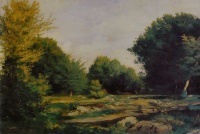Pierre-Auguste Renoir
From The Art and Popular Culture Encyclopedia
| Revision as of 14:30, 7 April 2022 Jahsonic (Talk | contribs) ← Previous diff |
Current revision Jahsonic (Talk | contribs) |
||
| Line 1: | Line 1: | ||
| + | {| class="toccolours" style="float: left; margin-left: 1em; margin-right: 2em; font-size: 85%; background:#c6dbf7; color:black; width:30em; max-width: 40%;" cellspacing="5" | ||
| + | | style="text-align: left;" | | ||
| + | "Having assimilated this new influence [[Pierre-Auguste Renoir |Renoir]] added it to his own store of knowledge, and four years later painted his greatest picture, ''[[Le Petit Peintre]]''. After this there was little more to be done in Renoir’s style unless he extended his vision to greater surfaces. This he has not done. But he has added other masterpieces to the ones already mentioned. His ''[[Ode aux Fleurs (d’après Anacréon)]]'', the two decorative Panneaux of the tambourine player and the dancer, ''[[Coco et les Deux Servantes]]'', ''[[La Rose dans les Cheveux]]'' and ''[[La Femme au Miroir]]'' are all worthy of a place beside the greatest pictures of all time."--''[[Modern Painting: Its Tendency and Meaning]]'' (1915) by Willard Huntington Wright | ||
| + | |||
| + | |} | ||
| + | [[Image:A Clearing in the Woods.jpg|thumb|right|200px|''[[A Clearing in the Woods]]'' (1865) by Pierre-Auguste Renoir]] | ||
| {{Template}} | {{Template}} | ||
| Line 5: | Line 11: | ||
| He was the father of filmmaker [[Jean Renoir]] (1894–1979). | He was the father of filmmaker [[Jean Renoir]] (1894–1979). | ||
| - | He is known for such paintings as ''[[Bal du moulin de la Galette]]'' (1876), ''[[A Clearing in the Woods]]'' (1865), ''[[Luncheon of the Boating Party]]'' (1881) and ''[[The Bathers (Renoir)|The Bathers]]'' (1918–19). | + | He is known for such paintings as ''[[A Clearing in the Woods]]'' (1865), ''[[Bal du moulin de la Galette]]'' (1876), ''[[Luncheon of the Boating Party]]'' (1881) and ''[[The Bathers (Renoir)|The Bathers]]'' (1918–19). |
| - | Other paintings include ''[[Mother Anthony's Tavern]]'' (1866), ''[[Diana (Renoir painting)|Diana]]'' (1867), ''[[Lise with a Parasol]]'' (1867), ''[[Frédéric Bazille at his Easel]]'' (1867), ''[[In Summer (Renoir)|In Summer]]'' (1868), ''[[Skaters in the Bois de Boulogne]]'' (1868), ''[[La Grenouillère]]'' (1869), ''[[A Nymph by a Stream]]'' (1869-70), ''[[Madame Clémentine Valensi Stora (L'Algérienne)|L'Algérienne]]'' (1870), ''[[La Promenade (Renoir)|La Promenade]]'' (1870), ''[[Bather with a Griffon Dog]]'' (1870), ''[[Woman with Parakeet]]'' (1871), ''[[Parisian Women in Algerian Costume (The Harem)|The Harem]]'' (1872), ''[[Le Pont-Neuf (Renoir)| Le Pont-Neuf]]'' (1872), ''[[Claude Monet Painting in His Garden at Argenteuil]]'' (1873), ''[[La Parisienne (Renoir painting)|La Parisienne]]'' (1874), ''[[La Loge]]'' (1874), ''[[The Grands Boulevards|The Grand Boulevards]]'' (1875), , * ''[[Portrait of the painter Claude Monet]]'' (1875), ''[[Female Nude (Renoir, 1876)|Nude woman sitting on a couch (Anna)]]'' (1876), ''[[The Swing (Pierre-Auguste Renoir)|The Swing]]'' (1876), ''[[A Girl with a Watering Can]]'' (1876), ''[[Mother and Children]]'' (1876), ''[[Lunch at the Restaurant Fournaise]]'' (1879), ''[[Paysage Bords de Seine]]'' (1879), ''[[Portrait of Irène Cahen d'Anvers|Portrait of Irène Cahen d'Anvers (La Petite Irène)]]'' (1880), ''[[Pink and Blue (Renoir)|Pink and Blue]]'' (1881), ''[[Two Sisters (On the Terrace)]]'' (1881) , ''[[Young Women in Black]]'' (1880-1882), ''[[Blonde Bather]]'' (1881 and 1882) , ''[[The Umbrellas (Renoir)|The Umbrellas]]'' (1880–81, 1885–86), ''[[By the Seashore]]'' (1883), ''[[Dance at Bougival]]'' (1883), ''[[Dance in the City]]'' (1883), ''[[Dance in the Country]]'' (1883), ''[[Les Grandes Baigneuses (Renoir)|Les Grandes Baigneuses]]'' (1884–1887), ''[[Nature morte: fleurs]]'' (1885), ''[[Young Woman with a Blue Ribbon]]'' (1888), ''[[Girls at the Piano]]'' (1892), ''[[Yvonne and Christine Lerolle at the Piano]]'' (1897), ''[[Woman Playing a Guitar]]'' (1897), ''[[Gabrielle with Open Blouse]]'' (1907), ''[[Nude (Renoir, Belgrade, 1910)|Nude]]'' (1910), ''[[After the Bath (Renoir)|After the Bath]]'' (1910), ''[[The Coast at Cagnes, Sea, Mountains]]'' (c. 1910), ''[[Portrait of Ambroise Vollard in a Red Headscarf]]'' (1911), ''[[The Farm at Les Collettes, Cagnes]]'' (c.1908–1914), ''[[Blond Girl with a Rose]]'' (1915–1917), ''[[Portrait of Adèle Besson]]'' (1918). | ||
| ==See also== | ==See also== | ||
| *[[History of painting]] | *[[History of painting]] | ||
Current revision
|
"Having assimilated this new influence Renoir added it to his own store of knowledge, and four years later painted his greatest picture, Le Petit Peintre. After this there was little more to be done in Renoir’s style unless he extended his vision to greater surfaces. This he has not done. But he has added other masterpieces to the ones already mentioned. His Ode aux Fleurs (d’après Anacréon), the two decorative Panneaux of the tambourine player and the dancer, Coco et les Deux Servantes, La Rose dans les Cheveux and La Femme au Miroir are all worthy of a place beside the greatest pictures of all time."--Modern Painting: Its Tendency and Meaning (1915) by Willard Huntington Wright |

|
Related e |
|
Featured: |
Pierre-Auguste Renoir (25 February 1841 – 3 December 1919) was a French painter working in the Impressionist style.
He was the father of filmmaker Jean Renoir (1894–1979).
He is known for such paintings as A Clearing in the Woods (1865), Bal du moulin de la Galette (1876), Luncheon of the Boating Party (1881) and The Bathers (1918–19).
See also

